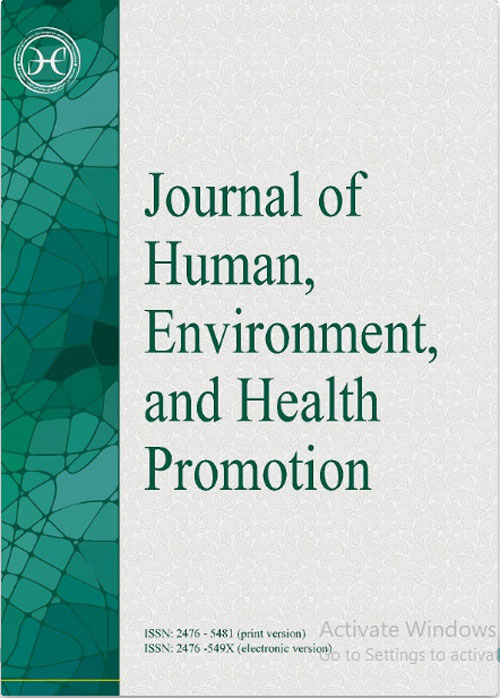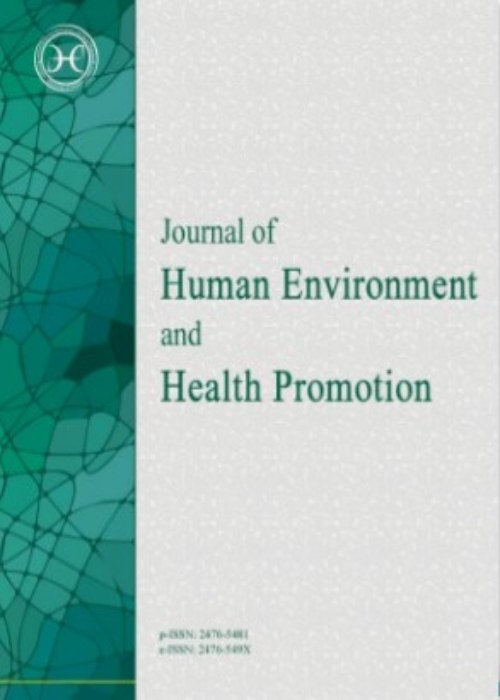فهرست مطالب

Journal of Human Environment and Health Promotion
Volume:5 Issue: 3, Summer 2019
- تاریخ انتشار: 1398/09/13
- تعداد عناوین: 8
-
-
Pages 98-103Background
Phenolic compounds are an important group of pollutants in industrial wastewater, which must be treated before disposal into water resources. The present study aimed to use synthesized graphene oxide (SGO) to remove bisphenol A (BPA) from aqueous solutions.
MethodsGraphene oxide was synthesized using Hummers' method, and BPA adsorption was assessed as a function of solution pH, contact time, adsorbent dosage, and initial BPA concentration using the batch method. Isotherms and kinetic evaluation of dye adsorption was performed using the equilibrium data.
ResultsAdsorption was rapid and strongly dependent on pH and adsorbent dosage, reaching the peak at the pH of 7 and adsorbent dosage of 0.8 g/l. BPA removal efficiency at the initial concentration of 10 mg/l was 98.8 ± 0.62%. Analysis of the experimental isotherm data using the Langmuir-Freundlich and Temkin models indicated that the removal process followed the Langmuir isotherm, while the adsorption kinetics followed the pseudo-second-order kinetic model. The maximum adsorption capacity was calculated by Langmuir fitting and determined to be 58.12 ± 1.14 mg/g.
ConclusionAccording to the results, SGO could be employed as an effective agent for the removal of BPA from aqueous solutions.
Keywords: Graphene oxide, Adsorption, Kinetics, Bisphenol A -
Pages 104-109Background
Unnecessary demand for healthcare services for patients is a major concern in health economics research, and social science researchers primarily use questionnaires. The present study aimed to evaluate the reliability and validity of the questionnaire of the prevention of induced demand for medicine prescription.
MethodsThis descriptive study was conducted after designing the primary questionnaire (63 items). The reliability and validity of the questionnaire were assessed by determining the face validity, content validity, construct validity, and reliability.
ResultsInitially, no items were eliminated in the qualitative assessment of face validity. To determine the content validity, six items were integrated due to overlapping, and 34 items remained. Principal component analysis revealed a three-factor solution to provide the best fit. Intraclass correlation and Cronbach's alpha for each component of the questionnaire confirmed its reliability.
ConclusionIn order for valid and reliable questionnaires, the views of the target group and experts must be considered and all the psychometric stages should be accomplished. Due to the differences in various studies, a single questionnaire cannot be used in every research.
Keywords: Reliability, Validity, Questionnaire, Prescription, Psychometrics -
Pages 110-115Background
The present study aimed to determine the antimicrobial effects of Lactobacillus acidophilus and Lactobacillus reuteri against Campylobacter jejuni in fresh and roasted chicken breast fillets.
MethodsFresh and roasted chicken breast fillets were soaked in probiotic suspensions (11 log CFU/ml) and immersed in C. jejuni suspension (5 and 3 log CFU/ml). Afterwards, the fillets were placed in clean stomacher bags and refrigerated for 10 days until further analysis.
ResultsThe count of 5 log CFU/g in the fresh fillets treated with L. acidophilus, L. reuteri, L. reuteri, and L. acidophilus reached 3.45, 3.89, and 4.25 log CFU/g after 10 days of refrigerated storage, respectively. In the roasted fillets, the corresponding counts were estimated at 2.99, 3.54, and 3.92 log CFU/g, respectively. In addition, the inoculated 3 log CFU/g of C. jejuni reached 1.09-1.11 log CFU/g after the refrigerated storage of the fresh and roasted chicken breast fillets.
ConclusionAccording to the results, the addition of L. acidophilus and L. reuteri to the fresh and roasted chicken breast fillets had inhibitory effects against the growth of C. jejuni.
Keywords: Campylobacter jejuni, Lactobacillus acidophilus, Lactobacillus reuteri -
Pages 116-120Background
Food security and access to sufficient healthy food are the basic needs of humans. Food insecurity may cause severe health and nutritional problems. Therefore, assessment of food security and the influential factors is essential in different communities. The present study aimed to determine the prevalence of food insecurity in the households in Kermanshah in the west of Iran.
MethodsThis cross-sectional study was conducted at 1,185 households in Kermanshah city, which were selected from eight areas via cluster sampling. Data were collected using the questionnaire of the United States Agency for International Development (USAID). Data analysis was performed in SPSS version 16 using the Kolmogorov-Smirnov test, Pearson's correlation-coefficient, and Kruskal-Wallis test.
ResultsIn total, 69.5% of the households had food insecurity. Significant correlations were observed between food insecurity and family size, occupation status of the household head, number of rooms, monthly income, and education level (P = 0.001).
ConclusionAccording to the results, food insecurity was highly prevalent in the families in Kermanshah. Therefore, planning and implementation of interventional programs by organizations are recommended for better food access and improving the quality and quantity of food consumption in families.
Keywords: Food insecurity, USAID, Questionnaire, Kermanshah, Iran, United States -
Pages 121-126Background
Several factors contribute to accidents in small-scale construction projects (SSCPs). The present study aimed to assess the influential factors in SSCP accidents and introduce a model to predict their frequency.
MethodsIn total, 38 SSCPs were within the scope of this investigation. The safety index of accident frequency rate (AFR) causing 452 injury construction accidents during 12 years (2007-2018) was analyzed and modeled. Data analysis was performed based on feature selection using Pearson's χ2 coefficient and SPSS modeler, as well as the artificial neural networks (ANNs) in MATLAB software.
ResultsMean AFR was estimated at 26.32 ± 14.83, and the results of both approaches revealed that individual factors, organizational factors, training factors, and risk management-related factors could predict the AFR involved in SSCPs.
ConclusionThe findings of this research could be reliably applied in the decision-making regarding safety and health construction issues. Furthermore, Pearson's correlation-coefficient and ANN modeling are considered to be reliable tools for accident modeling in SSCPs.
Keywords: Construction Projects, Accident, Modeling -
Pages 127-131Background
Eating disorders (EDs) are diseases of mental origin, which are associated with unusual eating behaviors. The structure of eating behaviors may differ depending on body weight and sleep status. The present study aimed to assess the prevalence of disordered eating attitudes and its associations with weight and sleep status in female adolescents in Zanjan, Iran.
MethodsThis cross-sectional study was conducted on 359 female students selected from the secondary high schools of Zanjan via random cluster sampling. Disordered eating attitudes and recent sleep quality were evaluated using the eating attitude test (EAT-26) and Pittsburgh sleep quality index (PSQI), respectively. In addition, anthropometric measurements were performed using standard protocols.
ResultsIn total, 22.3% of the subjects had disturbed eating attitudes. Moreover, comparison of disordered eating attitude in these subjects with healthy students indicated significant differences in terms of body weight (P <0.05) and body mass index (BMI) (P < 0.05).
ConclusionAccording to the results, abnormal eating attitude was highly prevalent in the students. Furthermore, the subjects with EDs had higher body weight, BMI, and PSQI scores, as well as shorter duration of sleep, compared to the others. And PSQI score along with shorter sleep duration than others.
Keywords: Eating disorders, Sleep quality, Body mass index, Obesity -
Pages 132-136Background
Savory herbs and their active essential oils have been extensively investigated as feed additives and an alternative to the use of antimicrobial agents. The present study aimed to assess their effects on broiler chicken performance.
MethodsDried savory powder (SP) (1.0% or 2.0%) or savory extract (SE) (50 or 100 ppm) was added to the basal starter (until day 22) and grower diets/drinking water, respectively. In total, 308 male Ross broilers aged 225 days were assigned to four treatment groups and the non-supplemented control group.
ResultsOn day 42, the feed conversion ratio (FCR), improved in the treatment groups (FCR =1.63 on 1.0% SP) compared to the control group (FCR =1.81±0.04; P < 0.005), while no such change was observed in the feed intake or daily weight gain. The FCR was similar between the SP and SE at different levels.
ConclusionAccording to the results, 1% or 2% savory powder and 50 or 100 ppm of the savory extract as food and drinking water additives could improve the FCR in the 42-day broiler production cycle and could be a proper alternative to commercial essential oils.
Keywords: Body weight, Broilers, Feed additives, Production cycle, Satureja hortensis -
Pages 137-144Background
Population growth and industrial and agricultural activities have increased the consumption of water, leading to clean water scarcity. Wastewater treatment is an important concern as determining proper sites for wastewater treatment plants (WWTP) largely influences proper operation. The present study aimed to determine an optimized site for WWTP in the rural complexes of Zanjanrood catchment in Zanjan province, Iran.
MethodsThe site priority map was generated using the geographical information system (GIS) and analytical hierarchy process (AHP). Locating of the plants was based on various parameters. After map preparation, the weight of each parameter was determined using the AHP approach, and the conversion of the layers was performed using the GIS. The site priority map for each sub-catchment was determined and optimized.
ResultsIn the criteria pairwise comparison matrix, the distance from the city had the highest value (16%), while the distance from the oil and gas transmission pipelines had the lowest value (1%). The site was located at the lowest elevation compared to the villages in each complex.
ConclusionAccording to the results, the AHP followed by the optimization method could pinpoint the optimal sites for the environmental protection of treatment plant construction in rural areas.
Keywords: Site selection, Wastewater treatment plant, Optimization, AHP, GIS


